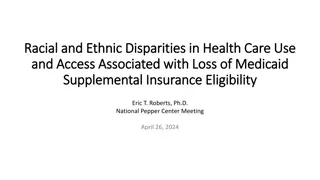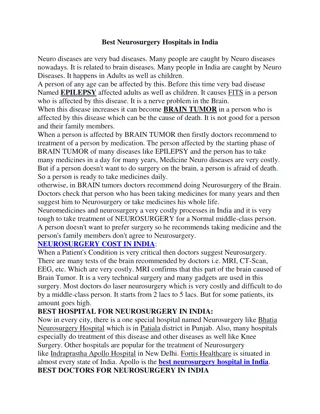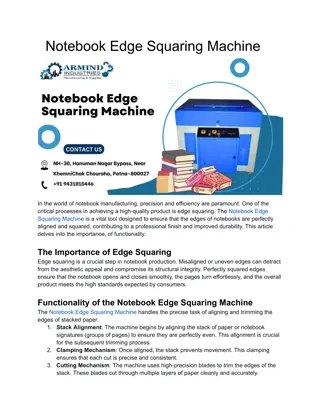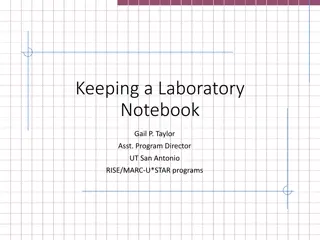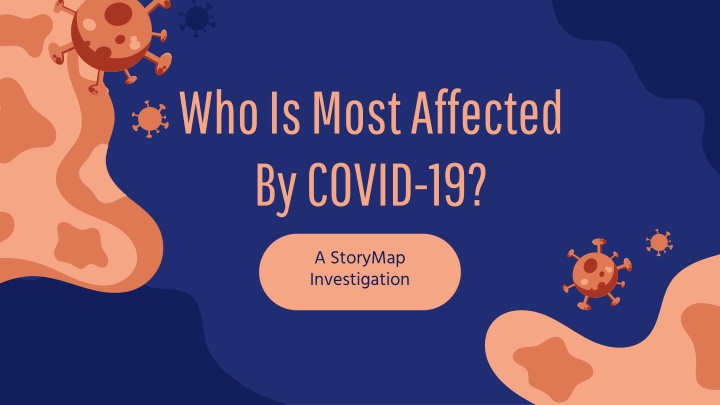
Investigating COVID-19 Impact Through StoryMap Exploration
Delve into the impacts of COVID-19 on different groups using a StoryMap investigation. Learn how to create frozen slides for interactive learning. Explore a variety of topics related to COVID-19 and social justice through guided questions and interactive elements.
Download Presentation

Please find below an Image/Link to download the presentation.
The content on the website is provided AS IS for your information and personal use only. It may not be sold, licensed, or shared on other websites without obtaining consent from the author. If you encounter any issues during the download, it is possible that the publisher has removed the file from their server.
You are allowed to download the files provided on this website for personal or commercial use, subject to the condition that they are used lawfully. All files are the property of their respective owners.
The content on the website is provided AS IS for your information and personal use only. It may not be sold, licensed, or shared on other websites without obtaining consent from the author.
E N D
Presentation Transcript
Who Is Most Affected By COVID-19? A StoryMap Investigation
Instructors Directions For Creating Frozen Slides The instructions below detail how to freeze slides to keep content in place, so students can only type in or interact with certain slide attributes. I find it helpful to keep both a frozen and an editable copy of the presentation to go back to edit portions as needed. 1. Create the slides you want to be frozen without the interactive pieces. Make a second blank presentation to keep as your Frozen copy and the initial presentation will remain editable. From your editable slides, select File and then Download . This will open up a drop-down menu with download options - select JPEG Image (current slide) . This will download your current slide as a JPEG image. Anything overhanging the edge of the slide or not on the slide will not be saved in the image. Unfortunately, you have to do this step for each individual slide, there is no bulk download option that separates the slides into individual JPEGs. On your blank presentation, select Background from the slides toolbar, then select image . You can drag the JPEG image of the slide you just downloaded into the dialogue box, which will upload the image as the slide background. Everything you put on that slide initially is now frozen as the slide background and cannot be edited or moved. Repeat steps for desired number of slides. Then add interactive pieces over top of the slide: text boxes, links, videos, data tables, images, etc. I find it helpful to make the interactive pieces, especially text boxes or links, stand out as a different color, rather than transparent and to include Type Answer Here . 2. 3. 4.
Your Task: Use the StoryMap (link on slide 4) to investigate a topic of your choice related to COVID-19 and social justice. Follow the numbered steps to conduct your investigation. Any questions you must answer will contain purple textboxes, click to type inside.
Exploration 01 01 You are just here to explore a little about the StoryMap.
StoryMap Link Click here to see the StoryMap Directions: Follow the link above and take a minute to read through the names of all of the tabs. Pick ONE that seems most interesting to you and use the questions on the following slide to guide your exploration.
Exploration Questions: What information can you find in the Map Details section of your tab? What does the legend tell you about your tab s map? Describe the Instructions for Use in your own words. Summarize the Data Details for your tab. Give an example of at least one connection from the Making Connections section of your tab. Click on one area of the map. What information can be found in the map pop-up? What is one key takeaway about your tab?
Select Your Topic 02 02 After exploring the StoryMap, select your topic. Use the Topic Tree and the Question Guide to help you. Tip: Use the tab you explored in the previous step as a starting point for choosing your topic.
Topic Tree Part 1: Choose Your Topic Select one topic from below that you want to investigate. You can choose to investigate more than one topic. Each topic represents one tab in the StoryMap. Income Income Poverty Rates Poverty Rates (Total Income Below Poverty Line) Access to Testing Access to Testing (By Region) Race Race Age Age Pollution Rates Pollution Rates (Levels of Pollution) (Average Household Income) (Racial Breakdown) (Birth Year) Option A: Exploration of ONE Topic Option B: Intersection of TWO Topics My Topic: ______________ My Topic #1: ______________ OR My Topic #2: ______________
Topic Tree Part 2: Choose Your Focus Now that you have chosen your topic, you need to choose a focus area or multiple areas. Each focus area is represented by a white box below each column header. Option A1 for 1 topic: Option A1 for 1 topic: Pick one focus area from the same column you chose on the last slide. Option A2 for 1 topic: areas from the same column you chose from the last slide. Option B for 2 topics: Option B for 2 topics: Choose one focus area from the same columns as each of your topics that you chose on the last slide. Record your selection on the next slide. Option A2 for 1 topic: Choose two focus Income Income Poverty Rates Poverty Rates (Total Income Below Poverty Line) Topics Access to Testing Access to Testing (By Region) Race Race Age Age Pollution Rates Pollution Rates (Levels of Pollution) (Average Household Income) (Racial Breakdown) (Birth Year) American <$15,000 Focus Areas Neighborhood High 1945/earlier High Indian/Alaska Native $15,000-$24,999 Asian Low County 1946-1964 Low $25,000-$34,999 Black/African American 1965-1980 $35,000-$49,999 State Hispanic/Latinx $50,000-$74,999 1981-1998 Native Hawaiian or Pacific Islander $75,000-$99,999 1999-2016 White $100K-$149,999 2017/after 2+ Races $150K-$199,999 Other $200K
Topic Tree Part 2: Choose Your Focus Depending on whether you selected one topic or two, you will choose option 1, 2, or 3. Use the focus areas listed below your topic listed on the previous slide and write out your focus area(s) below in the option that best suits your investigation. Option A1: Exploration of ONE Topic & ONE Focus Area Option A2: Comparison of ONE Topic & TWO Focus Areas My Focus Area: ______________ My Focus Area #1: ______________ OR My Focus Area #2: ______________ Sample Topic & Focus Area: Generation | 1965-1980 vs. 1981-1998 Sample Topic & Focus Area: Generation | 1965-1980 Option B: Intersection of TWO Topics & ONE Focus Area from Each Topic My Focus Area #1: ______________ (Topic 1) Sample Topics & Focus Areas: Generation | 1965-1980 vs. Race | Hispanic/Latinx My Focus Area #2: ______________ (Topic 2)
Question Generator Now that you ve chosen your topic and focus area(s), you need to create your research question. Following the same option that you have been using for the previous steps, use the question generator below to help you write your question. Option A1: Exploration of ONE Topic & ONE Focus Area How does COVID-19 affect those who _____________________ (Topic focus area)? Sample Question: How does COVID-19 affect those who were born between 1965-1980? Option A2: Comparison of ONE Topic & TWO Focus Areas How does COVID-19 affect those who ___________________ (focus area 1) versus ______________________ (focus area 2)? Sample Question: How does COVID-19 affect those who were born between 1965-1980 versus those who were born between 1981-1998? Option B: Intersection of TWO Topics & ONE Focus Area From Each How does COVID-19 affect those who _________________ (Topic 1 & focus area) and _________________ (Topic 2 & focus area)? Sample Question: How does COVID-19 affect those who were born between 1965-1980 and who are also Hispanic/Latinx?
What data do you think youll need to collect to be able to answer your question? The data you collect is dependent upon the topic and focus area(s) that you chose. Consider what information you will need to answer your research question and how many data points you need in order to see a pattern (remember science likes at least 5!). Here are some suggestions to get you started: Are you going to look at case numbers or death rates? 1. 1. What tabs will you need to reference to collect your data? What information are you going to record? (Hint: look at the tabs for your data, what data is available?) 1. How can you translate this information into a data table? In other words, how many rows and columns will you need? 1.
Investigation 03 03 Now that you have chosen your topic and come up with a research question, you can begin conducting your investigation. Directions: You should be following either option 1, 2, or 3 based on your research topic and question. The following slides contain data tables for each option. Option 1 (slide 13), Option 2 (slide 14), Option 3 (slide 15)
Option A1: Gathering Data For ONE Topic The data you collect depends on the topic and focus area(s) that you chose. Use the questions on slide 11 to help you focus on the data you are to collect and record it here by filling out the data table (see the data collection suggestions below in the notes on this slide). Remember, this is the MINIMUM amount of information to collect. You can always add more rows or columns by right clicking on the table and inserting a column or row. COVID-19 Levels For Topic Focus Area (put your investigation info here) Area 1: Area 2: Area 3: Area 4: Area 5:
Option A2: Gathering Data For Comparison of ONE Topic & TWO Focus Areas The data you collect depends on the topic and focus area(s) that you chose. Use the questions on slide 11 to help you focus on the data you are to collect and record it here by filling out the data table (see the data collection suggestions below in the notes on this slide). Remember, this is the MINIMUM amount of information to collect. You can always add more rows or columns by right clicking on the table and inserting a column or row. COVID-19 Levels For Topic Focus Area 1 (put your investigation info here) COVID-19 Levels For Topic Focus Area 2 (put your investigation info here) Area 1: Area 2: Area 3: Area 4: Area 5:
Option B: Gathering Data For Intersection of TWO Topics The data you collect depends on the topic and focus area(s) that you chose. Use the questions on slide 11 to help you focus on the data you are to collect and record it here by filling out the data table (see the data collection suggestions below in the notes on this slide). Remember, this is the MINIMUM amount of information to collect. You can always add more rows or columns by right clicking on the table and inserting a column or row. COVID-19 Levels For Topic 1 Focus Area (put your investigation info here) COVID-19 Levels For Topic 2 Focus Area (put your investigation info here) Area 1: Area 2: Area 3: Area 4: Area 5:
04 04 Analysis Now that you ve collected some data on your topic, answer the following questions.
1. According to your research question, who is most affected by COVID-19? a. Is this what you expected when you first began your investigation? Why or why not? a. Does this change the way you think about COVID-19 and its impacts? Explain why or why not. 1. How could we reduce the impact of COVID-19 on those most affected by it? 1. What was one thing you learned during your investigation? 1. What is one thing you want to know more about after conducting your investigation?
5. What science skills did you use in your investigation (list at least 2)? (consider what skills or steps you have used/followed in our previous labs) 5. Why do you think it is important to address or learn about COVID-19 and its impact on people (or similar topics)? 5. If you had to investigate one other tab or topic, what would it be and why?
Correlation vs. Causation When conducting scientific analysis, it is important to note the difference between correlation and causation. Causation refers to a direct cause between variables, where A causes B. Correlation is just a relationship between variables: A and B happen to be related, but A does not cause B. For example, if analyzing the data between cancer rates and cell phone usage, one might say that cell phone usage causes cancer, but the reality might be that cell phone use has become more widespread with people of older age, who have higher rates of cancer; thus the two things happen to be related, but one does not cause the other.
After learning about the difference between correlation and causation from the previous slide, do you think that the conclusion of your investigation demonstrates correlation or causation? Explain below.
05 05 Final Product Final Product Now that you ve considered the impact of your topic and investigation, create a slide to teach your classmates about what you learned.
Directions The following slide is a general outline for you to make your own - you do not have to stick to the outline, but the information should be consistent. You are to create a quick slide to teach your classmates about what you learned in your investigation. How can you convince your peers that your topic matters? The items listed below are information you are required to include somewhere on your slide. State your research question State the answer to your question Explain why these results matter. Provide your data Include 1 picture At least1 source that addresses your issue (hint: look at the StoryMap for source links or google search your topic)
[Title] [Research Question] [Answer to research question] [Data] [Why does this topic matter?] [Picture]
Turn this in to Google Classroom when you are finished CREDITS: This presentation template was created by Slidesgo Slidesgo, including icons by Flaticon, and infographics & images by Freepik Flaticon Freepik Please keep this slide for attribution



